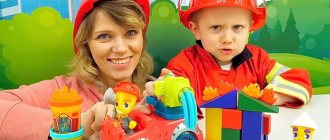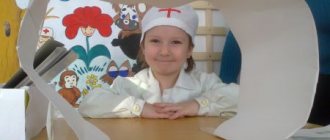Summary of the role-playing game "Children's Cafe"
Goal: to teach children the ability to play the role-playing game “Children’s Cafe”.
Tasks:
– develop and enrich the plot of the game in the “Children's Cafe”;
– develop creative imagination, the ability to develop the game together, coordinating your game plan with the plans of your peers;
– develop initiative, organizational skills, lead to the autonomous creation of game ideas;
– train the ability to negotiate, plan, discuss the actions of all players;
– consolidate children’s knowledge about the rules of behavior at the table and in public places;
– train children’s ability to prepare the environment for play, select replacement items and attributes;
What else to read: Role-playing project “Pharmacy” with children of senior preschool age with STD
– cultivate a respectful attitude towards people of different professions.
Organizational game "Water".
– Educator: Today there are those who will work and those who will rest. Who will work? (Me: cook, driver, conductor, waiters, auto mechanic, etc.)
– Can you make Helen’s holiday beautiful, tasty and fun?
– Dear bar workers, driver, auto mechanic, conductor, go get ready.
The teacher approaches the smart doll.
– Elena, call the kindergarten, invite your friends to relax at the bar.
Doll (lit): “I’ll call you on the phone,” brings the barbell to his ear. – Today is my birthday, I invite you to the bar for the holidays. Please, come".
Teacher
– Dear parents, the children are now in kindergarten, and you are building a house, get ready for the holidays. When you're done, pick up the kids from daycare, dress them up, and take the bus to the cafe.
Children - cafe employees - build a kitchen, set tables, make ovens, prepare dishes from substitutes, and prepare a menu.
Children - parents - put mirrors and sinks in the house. After that, they go to kindergarten and can wear beauty.
Teacher
– Parents, children are waiting for you, don’t hesitate. Driver and conductor, make sure the bus is clean and comfortable, mechanic, check if the bus is working properly. (Children wash the windows, sweep the bus they built with chairs, make a steering wheel, inflate the tires, fill up with gasoline, etc.)
In kindergarten, the teacher plays the role of a teacher, and the children, in the role of parents, come for dolls.
– Are you going somewhere? Your daughter said she was going to the bar? Have fun and enjoy!
– Have you prepared any gifts?
They go by bus.
Educator:
- Go to the bar. I’m very worried, I want the holiday to work. Tell the waiters where is the birthday girl?
Place the Lena doll on a chair in the center of the bar so that you can dance a round dance (loaf).
– Whose daughter or son do you want to congratulate Lena?
– Mom invites guests to the table with her daughter.
(Parents and children hold dolls on their laps. Waiters offer menus, place dishes on the table and say their names.)
Educator:
– The birthday girl wants to show her the fairy tale “Rapa”. Name the mother of the birthday girl who will come. Guests please sit on chairs for comfortable viewing.
Children play the fairy tale "Turnip".
Educator:
- Already evening. It's time to go out, the cafe is closing.
Cleaning.
Organizational game "Circle-Circle".
Let's talk about games with children.
- Do you think your vacation was fun?
- What gifts did Lena receive?
- Was it nice to give Lena gifts?
- And what do the waiters think, did they manage to create a holiday for Lenochka?
- Did you enjoy serving your guests?
- What did the chefs prepare?
- How do you know if your guests liked your dishes?
- Was the holiday fun?
- Will other guests want to come to this cafe?
Appendix 2 (week 4)
Role-playing game “Kindergarten”
Purpose : To consolidate children’s knowledge about the work of a nurse, laundress, cook, janitor and other kindergarten workers.
Tasks :
- Development of the ability to apply acquired knowledge in collective creative
- game.
- Continue to teach children to distribute roles, agreeing and following
- the proposed plot.
- To develop the ability to creatively develop the plot of the game.
- Enrichment of vocabulary through words used in a situation
- communication with each other on the topic “Kindergarten”.
- Developing a sense of gratitude for the work adults do for them, a desire to provide
- help them as much as possible.
- Foster interest and respect for the work of kindergarten employees.
Techniques:
- Looking at illustrations about kindergarten.
- Tours of the kindergarten premises.
- Conversations “Who works in kindergarten and how”, “Maintaining a daily routine.”
- Didactic game “What do children do?”
- "Doll kindergarten"
- Reading poems about kindergarten.
- Individual orders.
- Duty roster.
- Joint play between children and the teacher (at first), assistance in assigning roles, tracking the storyline.
- In subsequent days, it is possible to combine 2 and 3 role-playing games “Hospital”, “Home”) with one plot.
During play, children imitate what they do in kindergarten (gymnastics, breakfast, washing, games, etc.)
Appendix 3 (week 4)
Cognitive and research (constructive) activity - designing “What interesting things were remembered during excursions around the kindergarten” (construction of a hall and group).
Goal : To develop the ability to design buildings depending on their purpose.
Tasks:
- Learn to convey ideas in buildings.
- Teach children to build kindergarten premises.
- Develop the ability to come up with ways to design garden spaces so that everything stands firmly.
- Develop children’s own constructive ideas.
- Develop the ability to negotiate and build together.
- To instill in children respect for the work of adult builders who build socially significant objects for people.
Techniques:
- Conversation with children about the premises of the kindergarten.
- Joint discussion of the construction of premises. (Decision to build a group and a gym).
- Do you remember what equipment is in the hall?
- What furniture is in the group, what building material can be built from (table, chair, sofa, etc.)
- Children's contract on construction.
- Carrying out “construction work”.
- Help for children (verbal, effective).
- Result - what happened? Would you like to play around with this building?
- Was it difficult to carry out construction work using a wooden constructor?
- Invite children to play in the constructed premises.
Literature
- Dybina O.V. “Acquaintance with the subject and social environment” Moscow: “Mosaic-Synthesis”, 2014.
- Kutsakova L.V. “Labor education in kindergarten” Moscow: “Mosaika-Sintez”, 2014.
- Kutsakova L.V. “design from building materials” Moscow: “Mosaika-Sintez”, 2014.
- Yagodinsky V.N. “How to behave.” Moscow: “Knowledge”, 1991.
- Kupina N.A. "The ABCs of Behavior." Sverdlovsk: Ural University Publishing House, 1991.
- Lykova I.A. “Fine creativity in kindergarten” (Travel in slippers, felt boots, flippers, barefoot, on a flying carpet and in a time machine).
- Kazakova T.G. “Develop creativity in preschoolers” Moscow: “Enlightenment”, 1985.
- Krasnoshchekova N.V. “Plot-role-playing games for preschool children.” Rostov: “Phoenix”, 2007.
- The story of E. Permyak “How Masha became big.”
- Story by E. Permyak “The Worst Thing.”
- The story of E. Permyak “How Misha wanted to outwit his mother.”
- Yu. Yakovlev's story "The Sick"
- The story of Yu. Sinitsin “There is trouble with a man.”
- Story by I. Turichin “A Man Got Sick”
- The fairy tale “Doctor Aibolit” by K.I. Chukovsky.
- Poem by Z. Alexandrova “Katya in the manger”
- Poem “Kindergarten” (N. Yaroslavtsev)
- Poem “Preschool Children” (I. Gurina)
- Poem “Your Second Home” (G. Shalaeva)
- Poem “Kindergarten” (O. Vysotskaya)
- Poem “To kindergarten” (A. Vishnevskaya)
- Poem “Our beloved kindergarten” (E. Grudanov).
- Song "Kindergarten" lyrics by T. Volgina, music by A. Filippenko.
- Song “House with windows to childhood” (N. Agoshkova)
- Song “Kindergarten” (T. Kersten)
Go to the content of the short-term project “Our Favorite Kindergarten”
Appendix 1 (week 4)
Getting to know the walking areas of different groups. Goal : to form children’s idea of kindergarten.
Continue to get acquainted with the territory of the kindergarten: the main building, walking and sports areas. Tasks :
- Teach children to navigate the territory of the kindergarten.
- Know the location of your site and the sites of other groups.
- Activate children's speech using words used in
- situations in which children communicate with each other.
- Develop memory and cognitive interests in children.
- Introduce children to the rules of communication and rules of conduct in
- in public places.
- To cultivate respect for the work of people who provide us with cleanliness and
- order in kindergarten.
Techniques:
- Conversation with the children about the fact that we will now go to visit the children of other groups.
- Clarify with your children the rules of behavior that they are already familiar with.
- At the site, say hello, ask permission from the teacher and children about
- to see the site and play together.
- Get to know the teacher and children.
- Offer to see what is on the playgrounds of different
- groups.
- Specify the name of metal structures and equipment, their
- location and color.
- Offer to play with the children of the group we came to
- guests.
- During the game, pay attention to friendly relations with each other
- with a friend, verbally reward for the help provided.
- At the end, thank the teacher and children for their hospitality and invite
- them to visit their site.
- At your site, talk about whether the children liked it? Do they want
- further communication with children of other groups? What do they like most?
- did you remember and like it?
The result is that we visited another group’s site, met the children, and played different games. We helped new friends, if our help was needed, we negotiated with them. We all had fun and interesting.
And so visit all areas of the kindergarten, getting to know the teachers, children, the name of the group and the location and equipment of the areas.




